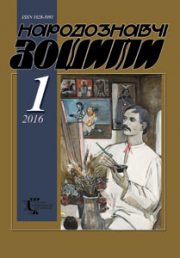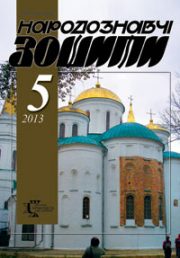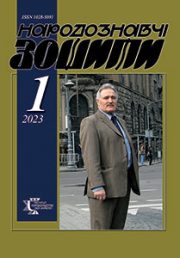The Ethnology Notebooks. 2018, № 4 (142), 939–948
UDK 75.03+7.07–05(477.87) А. Кашшай
DOI https://doi.org/10.15407/nz2018.04.939
Received 07.07.2018
ORIGIN AND THE FIRST USE OF VELUM
ORCID ID: https://orcid.org/0000-0002-7411-0574
Matveeva Julia Genadiivna, a candidate of study of art,
associate professor
of department, is a design and fine art
The Kharkiv national university of municipal economy
of the name of О.M. Beketova
61002, Kharkiv, Kulykivs’kyi lowering, 12, Ukraine
Contacts: e-mail: matveyevoy@gmail.com
Abstrakt. The aim of work is to understand iconographic, historical and cultural principles according to which a fabric, called in icono¬graphy «velum», began to play a significant role in the church art of the Byzantine tradition. Its origin is de–rived from real fabrics used in the Mediterranean culture. They include curtains on a ciborium, curtains on the door of a church and curtains on its columns, which originally appeared in iconography as real objects. Gradually the cultural role of curtains decreased but they remained in iconography as symbols. Since the connection with the real objects had already been lost, the images of these fabrics began to acquire fantastic exaggerated forms, but the principles of their symbolic use in iconography remained. Symbolism of the veils is associated with their primary use – separation of a sacred space, a transition from one space to another one, a combination of two symbolically different zones of an icon.
Keywords: icon, velum, curtain, fabric, ciborium.
REFERENCES
Velum. (2004). In Pravoslavnaia entsyklopedyia (T. 7, p. 537). Moskva [in Russian].
Herman Konstantynopol’skyj. (1995). Svt Skazanie o Tserkve y rassmotrenye taynstv. Moskva: Martys [in Russian].
Zhehyn, L.F. (1970). Yazyk zhyvopysnoho proizvedenyia. Moskva: Iskusstvo [in Russian].
Lazarev, V.N. (1986). Istoriia vyzantijskoj zhyvopisi. Moskva: Iskusstvo [in Russian].
Matveeva, Iu.H. (2016). Dekoratyvnye tkani v mozaikakh Ravenny: semantyka y kul’turno–smyslovoj kontekst. Kiev: Dukh i litera [in Russian].
Taft, R.F. (2010). Upadok prychascheniia v Vyzantii i otdalenie myrian ot liturhicheskoho dejstva: prychina, sledstvie ili ni to, ni druhoe? (D. Zanaveshennyj altar’). In Stat’i. (T. 1: Liturhyka, pp. 342–365.). Omsk: Holovanov [in Russian].
Fylatov, V.V. (1996). Kratkij ikonopysnyj illiustrirovannyj slovar’. Moskva: Prosveschenie [in Russian].
Shalyna, Y.A. (2000). Vkhod «Sviataia Sviatykh» i vizantijskaia altarnaia prehrada. In Lidov A.M. (Ed.), Ikonostas: Proiskhozhdenie – razvitie – symvolika (pp. 52–84). Moskva: Prohress–Tradytsyia [in Russian].
Yazykova, Y.K. (1994). Bohoslovie ikony. Moskva: Izdatel’stvo Obschedostupnoho Pravoslavnoho Unyversyteta [in Russian].
Kazdan, A. (1991). Velum. In The Oxford Dictionary of Byzantium (Vol. 3.). New York; Oxford: Oxford University Press.
Lamp, G.W.H. (1961). Patristic Greek Lexicon. Oxford: At the Clarendon Press.
Sophocles, A.E. (1992). Greek Lexicon of the Roman and Byzantine Periods. In Georg Olms Verlag Hildeshem. Zыrich; New York.
Migne, J.P. (Ed.). (1863). Patrologia curcus completes. Ser. Graeca (T. 108.). Paris.
Evans, H.C., & Wixom W.D. (Eds.). (1997). The Glory of Byzantium. Art and Culture of the Middle Byzantine Era. New York: The Metropolitan Museum of Art.
Wessel, K. Ciborium. (1966). Reallexikon zur byzantinischen Kunst. Unter Mitwirkung von Marcel Restle Herausgegeben von Klaus Wessel. (Band 1, pp. 1055–1068). Stuttgart: Anton Hierseman [in German].
Andrej Rublev. Blahoveschenie. Retrieved from: http://nearyou.ru/rublev/vlad/vl2blagov.html (Last accessed: 20.06.2018).
Velum. Retrieved from: http://ru.wikipedia.org/wiki/Velum (Last accessed: 20.06.2018).
Manuscript – Vat. gr. 1613. Retrieved from: https://digi.vatlib.it/view/MSS_Vat.gr.1613 (Last accessed: 20.06.2018).






